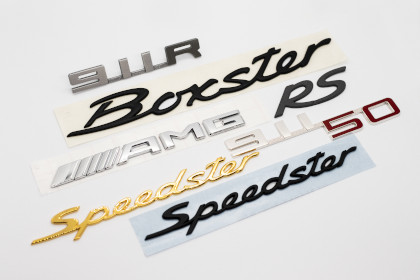Thermoplastic injection molding
>Thermoplastic injection molding plastic emblems
 The oldest and still most widely used process is thermoplastic injection molding.
The oldest and still most widely used process is thermoplastic injection molding.
A separate, usually very cost-intensive but durable tool is required for each emblem to be produced, since the workpieces tend to be stiff due to the materials used, among other things, and an emblem for a flat surface, for example, is not suitable for a curved one at the same time. Tooling takes a lot of time, which is why a long-term schedule is needed.
In thermoplastic injection molding, a wide variety of thermoplastics can be processed, depending on the requirements.
The injection molding process
First, the desired plastic material is filled as granules by means of a feed hopper into a heated barrel with an internal piston in the form of a screw. These components form the injection unit of the machine. With its rotary motion, the screw conveys the granules to the tip, where, due to the heat supply from heating and friction, they are present as a molten, pressurized, homogeneous plastic mass with a temperature of approx. 200 °C to 300 °C. The plastic material is then injected into the barrel. As soon as sufficient plastic melt is available to fill the mold, the injection unit is moved to the clamping unit, where the mold, which is also temperature-controlled but much cooler at approx. 20 °C to 120 °C depending on the material, is located, and the thermoplastic is compressed by a stroke movement of the screw piston. The melt is forced into the mold through the opening die, where pressures of between 500 bar and a maximum of 2000 bar can act. To counteract any shrinkage that may occur, recompression is also carried out for a short time after mold filling by means of the screw piston until the sprue has solidified. The nozzle is then closed and the injection unit separated from the clamping unit, which remains closed, so as not to influence the cooling process of the mold and to allow the injection unit to be filled with granules again.
Once the mold and the thermoplastic workpiece now contained therein have reached a certain temperature and the workpiece is dimensionally stable, it is ejected from the two-part mold and, if necessary, passed on by means of a handling device for separation of the sprue.
The injection-molded workpieces must be subsequently painted or chrome-plated to make them visually appealing and durable plastic emblems.
Once the mold and the thermoplastic workpiece now contained therein have reached a certain temperature and the workpiece is dimensionally stable, it is ejected from the two-part mold and, if necessary, passed on by means of a handling device for separation of the sprue.
The injection-molded workpieces must be subsequently painted or chrome-plated to make them visually appealing and durable plastic emblems.
In general, thermoplastic injection molded parts meet the highest quality standards in the plastics sector, but due to the high investment costs for the mold - in the case of very large quantities, several molds may be required over the project duration - they have their price, both financially and in terms of the rather less available flexibility due to the long mold manufacturing times.
FAQ – Thermoplastic Injection Molding
What is Thermoplastic Injection Molding?
Thermoplastic injection molding is a process in which thermoplastic materials are injected into a mold to produce components or emblems. The plastic granulate is melted and pressed into a mold under high pressure, where it cools and hardens.
For what applications is thermoplastic injection molding suitable?
This process is ideal for producing components and emblems that need to be durable, heat-resistant, and resistant to environmental factors. It is widely used in the automotive, electronics, and consumer goods industries.
What are the advantages of thermoplastic injection molding?
Thermoplastic injection molding offers many advantages, such as high efficiency in mass production, flexibility in material choice, and the ability to precisely manufacture complex geometries. Additionally, the produced parts are robust and resistant to environmental influences.
What are the typical cost factors in thermoplastic injection molding?
The costs primarily consist of the initial investment in creating the mold and material costs. Especially for large quantities, the initial mold costs are high since durable molds must be created that withstand long production periods.
What materials are used in thermoplastic injection molding?
Many different thermoplastics can be used, depending on the requirements of the final product. Common materials include polyethylene (PE), polypropylene (PP), and polycarbonate (PC).
How long does it take to create a thermoplastic injection mold?
Creating a mold can take a significant amount of time, as it needs to be specifically designed and manufactured for the respective component. For long-term projects, detailed planning is therefore necessary.
What post-processing steps are possible?
After injection molding, parts can be painted or chrome-plated to achieve a high-quality finish. CNC machining for fine-tuning details is also possible.
What is the difference between thermoplastic injection molding and thermoset injection molding?
In thermoplastic injection molding, the material becomes moldable by heating, whereas thermoset plastics are materials that cannot be reshaped after curing. Thermoplastics, however, remain thermally reusable.
Contact Us

